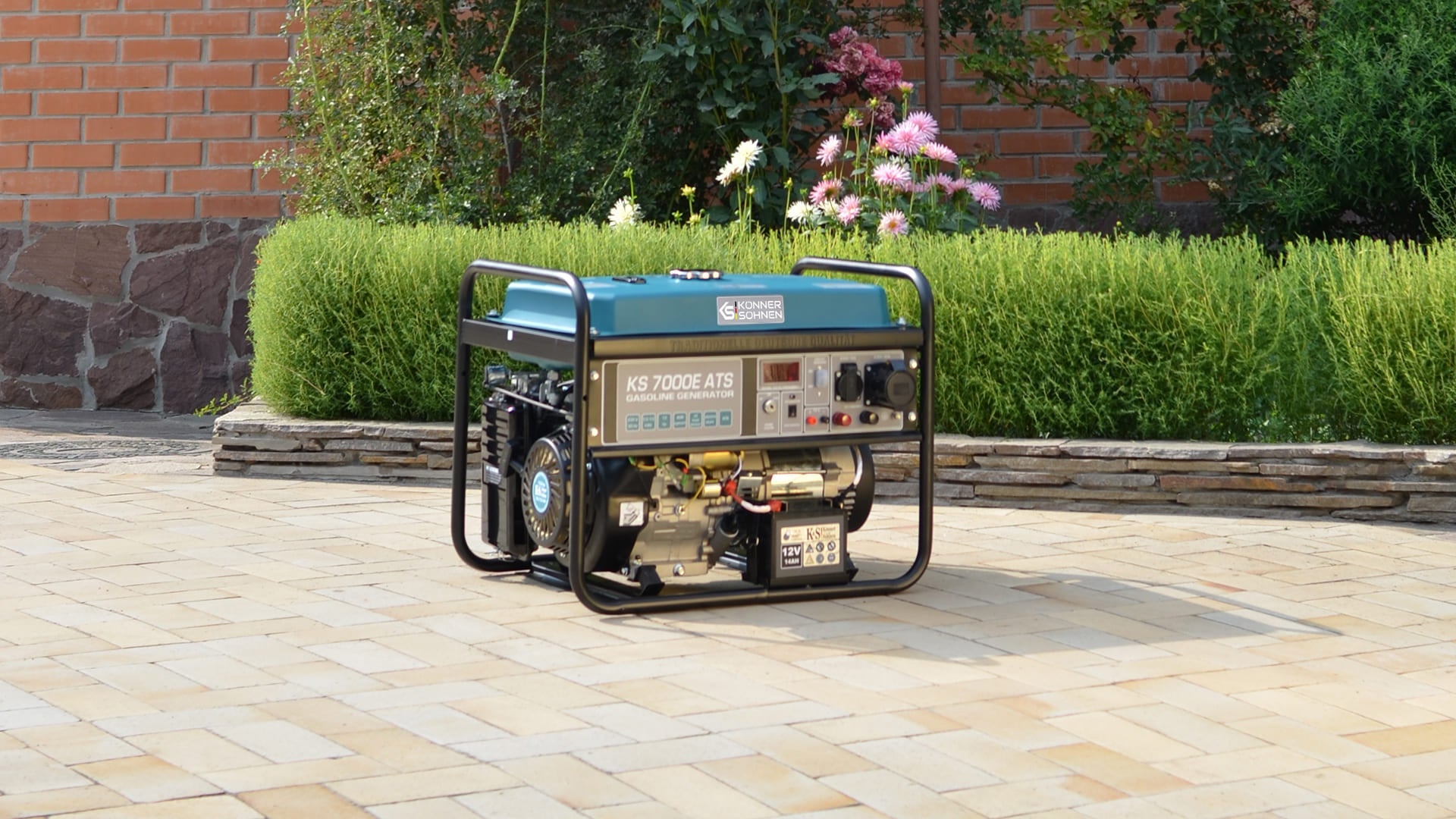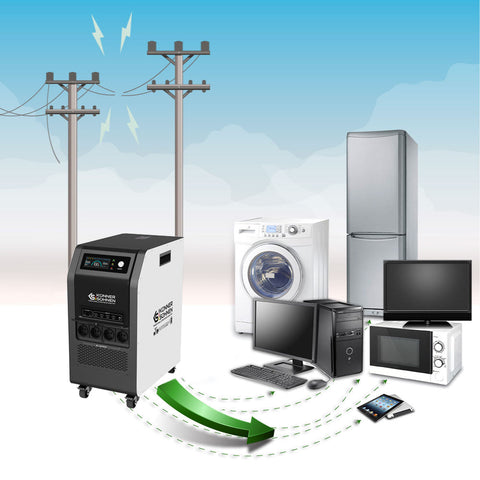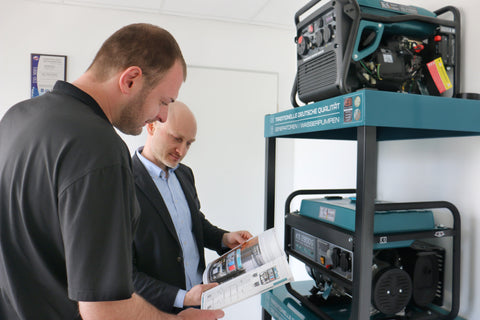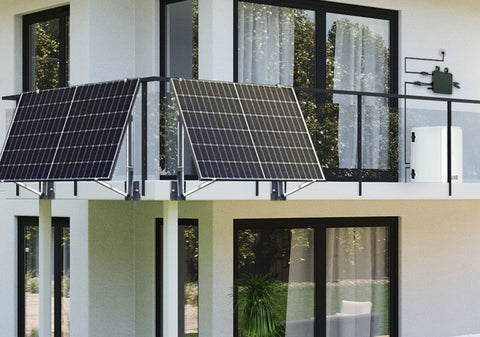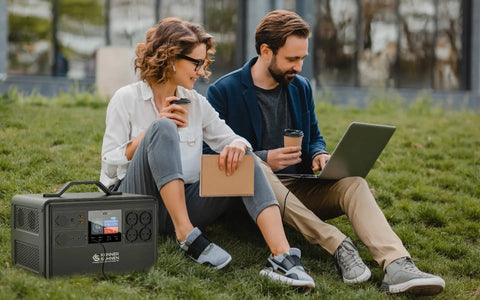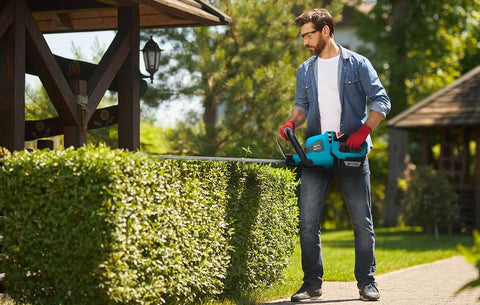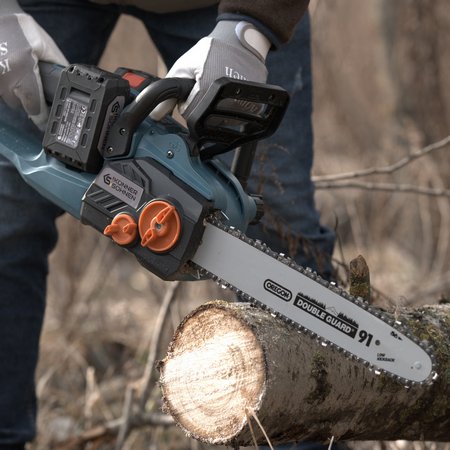Modeli KS 7000E ATS, KS 10000E ATS, KS 7000E-3 ATS i KS 10000E-3 ATS opremljeni su unutrašnjim ATS modulima i imaju neke posebne karakteristike u upotrebi koje se moraju strogo poštovati.
Generatori sa unutrašnjim ATS-om namenjeni su kao izvor napajanja u hitnim slučajevima za pojedinačne neosetljive potrošače ili grupe njih, čije napajanje je trajno obezbeđeno ATS modulom ugrađenim u generator.
ATS instaliran u generatoru ne omogućava potpuno napajanje kuće. Potrošači snage od 230V i 400V treba da se napajaju odvojeno, jer su generatori od 400V samo ograničeno korisni za potrošače snage od 230V.
Preporučeni plan povezivanja za potrošače snage od 230V ovlašćene za napajanje u hitnim slučajevima u skladu sa VDN smernicama za planiranje, izgradnju i rad sistema sa generatorima za hitno napajanje za generatore od 230V kao što su KS 7000E ATS i KS 10000E ATS:

Napajanje mora biti povezano pomoću odgovarajućeg kabla za napajanje preko minijaturnog prekidača. Ako je potrebno, mora se instalirati i uređaj za zaštitu od kontakta (uređaj za preostalu struju). Preporučujemo korišćenje fleksibilnog bakarnog kabla sa poprečnim presekom od 4-6 mm² (2.5-4 mm² za trofazne modele) po provodniku. Isti poprečni presek mora se koristiti i za priključni kabl (Schuko ili CEE utičnica, u zavisnosti od opterećenja).
Neophodno je obratiti pažnju na maksimalnu dozvoljenu struju napred za svaki model.
Maksimalna dozvoljena struja kroz CEE utičnicu (uključujući reaktivnu struju) je 25A (KS 7000E ATS) ili 32A (KS 10000E ATS) i za trofazne modele od 400V 3 x 8A (KS 7000E-3 ATS) ili 3 x 12A (KS 10000E-3 ATS).
Snažni potrošači snage od 230V kao što su električni šporeti, protočni bojleri, saune itd., koji su povezani na tri faze spoljne elektroenergetske mreže radi raspodele opterećenja tokom normalnog rada, ne smeju biti trajno napajani iz generatora ATS, već se mogu uključiti samo putem spoljnog prekidača za prebacivanje opterećenja.
Iako je trofazni električni šporet povezan na tri faze, on je obično potrošač snage od 230V, sa grejnim elementima podeljenim u tri grupe radi raspodele opterećenja. Može se napajati jednom fazom od 230V iz generatora. Međutim, nije moguće istovremeno aktivirati sve zone kuvanja i rernu kako bi se izbeglo preopterećenje neutralnog provodnika do električnog šporeta iz razvodne kutije.
Trofazni potrošači ne smeju biti povezani, jer zahtevaju 3 x 230V sa faznim pomakom od 120°.
Preporučeni plan povezivanja za trajno hitno napajanje i preklopive potrošače energije od 230V:

Na primer, krug bi mogao trajno napajati potrošače energije kao što su svetla kroz generator ATS, dok bi druge potrošače hitne struje povezivao kroz dodatni prekidač za prebacivanje opterećenja. Ovo smanjuje opterećenje kabla do generatora i generator ATS-a tokom normalnog rada i posebno je važno za bezbedan rad ako se generator treba instalirati na udaljenosti.
Da biste zaštitili osetljive elektronske potrošače energije, preporučujemo da uvek imate povezano otpornog opterećenja u aktivnom krugu prilikom rada generatora (najmanje 100W), što može prigušiti prolazne procese uzrokovane vršnom potrošnjom struje od strane elektronskih potrošača energije.
Napon (žuti) i struja (zeleni) konvencionalnog generatora sa AVR pod elektronskim opterećenjem bez i sa balansirajućim opterećenjem (sijalica od 100W):


Možete videti da su uznemirujuće harmonike označene crvenim strelicama na levoj slici mnogo manje na desnoj slici i većina elektronskih modula tada funkcioniše bez problema.
Molimo vas da se uverite da neutralni provodnik (zvezdasta tačka) namotaja generatora NIJE povezan sa kućištem generatora i PE provodnikom u utičnicama.
L i N veze iz javne mreže se usmeravaju od ATS-a do izlaznih utičnica i izlazni neutralni provodnik se time uzemljuje u TN i TT spoljnjoj mreži.
U slučaju nestanka struje, izlaz (dve utičnice) se prebacuje na namotaje generatora, a javna mreža se sigurno isključuje na svim polovima (uključujući neutralni provodnik). Uzemljenje neutralnog provodnika od strane javne mreže (ako postoji) se time uklanja.

Ako vam je i dalje potreban uzemljeni neutralni provodnik (TN mreža), morate čvrsto povezati neutralni provodnik (zvezdasta tačka) ispod poklopca alternatora sa kućištem alternatora (PE) prilikom instalacije generatora (most).

Kada je džamper između N i PE instaliran, generator se više ne sme koristiti bez uzemljenja. Generator se uzemljuje povezivanjem uzemljujućeg šrafa na generatoru sa bakarnim kablom od 6-10 mm² na glavnu uzemljujuću šinu u kući, ili korišćenjem sopstvenog uzemljujućeg sistema generatora.
Neophodno je proveriti povezivanje L i N na utičnice. Minijaturni prekidači instalirani u generatoru mogu prekinuti samo L provodnike u TN mreži. Potrebno je proveriti raspored pinova u polaritetno zaštićenoj CEE utičnici.

Modeli KS 7000E-3 ATS i KS 10000E-3 ATS su dizajnirani kao izvori hitne struje za trofazne potrošače od 400V koji simetrično opterećuju sve tri faze. Maksimalno dozvoljeno neuravnoteženo opterećenje za ove modele je 20%; u suprotnom, napon po fazi od 230V ± 10% više ne može biti zagarantovan. Potpuno napajanje domaćinstva nije moguće sa ovim modelima!
Preporučeni plan povezivanja za trofazne potrošače 400V (motori, pumpe, itd.) koji imaju pravo na rezervno napajanje u skladu sa VDN smernicom za planiranje, izgradnju i rad sistema sa generatorima rezervnog napajanja:

Minijaturni prekidač u generatoru štiti samo priključni kabl od generatora do potrošača snage. Apsolutno je neophodno zaštititi dovodni kabl do generatora na strani priključka (vidi šemu ožičenja) sa minijaturnim prekidačem. Za trofazne modele KS 7000E-3 ATS i KS 10000E-3 ATS, ovo treba da bude 3 x 10A ili 3 x 16A. Ako je potrebno, mora se instalirati i uređaj za zaštitu od kontakta (prekidač diferencijalne struje).
Šuko utičnica na modelima KS 7000E-3 ATS i KS 10000E-3 ATS povezana je paralelno sa fazom u CEE 400V 16A utičnici i može se opteretiti samo umereno (do 200-300W) sa neosetljivim potrošačima snage. Veća opterećenja (do 20% ukupne snage generatora) su moguća samo ako nema potrošača snage povezanih na CEE 400V 16A utičnicu.
PAŽNJA OPASNOST! Kontinuirani rad sa visokim strujama i priključnim kablom sa premalim presekom i lošim kontaktom na konektorima može dovesti do požara!
U slučaju nestanka struje, izlaz (dve utičnice) se prebacuje na namotaje generatora, a spoljna elektroenergetska mreža se bezbedno isključuje na svim polovima (uključujući neutralni provodnik). Ovo eliminiše uzemljenje neutralnog provodnika od strane javne elektroenergetske mreže (ako postoji).

Ako vam je i dalje potreban uzemljeni neutralni provodnik (TN mreža), morate čvrsto povezati neutralni provodnik (zvezdasta tačka) ispod poklopca alternatora sa kućištem alternatora (PE) prilikom instalacije generatora (most).

VAŽNO: Izbor odgovarajućeg generatora treba obaviti pažljivo, jer neodgovarajući generator ne samo da može ugroziti predviđenu upotrebu, već može oštetiti opremu i predstavljati rizik sam po sebi. Potrošači čiste otporne snage ne predstavljaju problem za sve tipove generatora. Za opremu sa motorima, mora se uzeti u obzir potrebna početna snaga. Nelinearni potrošači snage, a posebno elektronski uređaji bez ugrađene korekcije faktora snage, zahtevaju rešenje prilagođeno tačno specifičnoj primeni.
Odricanje od odgovornosti:
Ovaj priručnik je namenjen samo kao vodič, ilustrativan je i mora biti prilagođen specifičnim okolnostima i uslovima na licu mesta tokom instalacije. Sama instalacija mora biti izvedena u skladu sa svim standardima i propisima. Ne preuzimamo odgovornost za nepravilne instalacije i njihove posledice.
